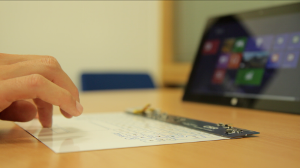Sep 4 2013
Bluetooth® Smart innovator CSR plc has developed the world’s thinnest wireless touch interface to demonstrate the revolutionary potential of the technology for computing interfaces. The flexible device, which is less than 0.5 mm thick, turns any area into a touch surface.
 World’s thinnest wireless touch surface enabled by CSR’s Bluetooth® Smart
World’s thinnest wireless touch surface enabled by CSR’s Bluetooth® Smart
Combining CSR’s low-power wireless technology with the latest in printable, flexible electronics and touch screen sensing, the device can be used to extend the touch interface of tablets and smartphones.
Lightweight and flexible, the device can be integrated into a protective cover or used to create large touch zones on a desktop. With minimal weight and bulk, a full keyboard experience can be added to a tablet without taking up valuable screen area. Thin enough to slip behind the pages of a notebook, it can be used to pick up handwriting and sketches from the nib of a modified pen.
The paper-thin surface is wirelessly connected using the recently launched CSR1010® chip, part of the CSR µEnergy® range, which is optimized solely for Bluetooth Smart. This allows it to connect to the latest iOS7 mobile devices and Windows 8 PCs using a fraction of the power of standard Bluetooth, enabling market-leading battery life and maintaining the smallest form factor. Touch latency is also minimized to less than 12mS, ensuring near instant visual feedback and enabling a seamless user experience.
“Consumers want innovative, portable wireless accessories that just work with their mobile devices,” says Paul Williamson, Director of Low Power Wireless at CSR. “The ultra-thin touch surface we’ve developed is a perfect example of how Bluetooth Smart can give them just that. We’re committed to working collaboratively with developers using the CSR µEnergy platform to help them bring similar next-generation accessories to the market quickly.”
CSR partnered with Atmel and Conductive Inkjet Technology (CIT) to develop the ultra-thin wireless touch surface. The device uses Atmel’s touch silicon to sense multiple contact points on a surface, and can offer a full touch surface or power optimized key detection. The flexible membrane is enabled by CIT printed conductors. CIT’s reel-to-reel printing process enables copper and other conductors to be applied to the surface of the ultra-thin and flexible membrane, and can be printed to fit a range of tablet shapes and sizes.
CSR’s ultra-thin touch surface will be unveiled to customers for the first time at IFA Berlin (Hall 1.2 Stand 104) from September 6-11, 2013.
Supporting video content: https://www.youtube.com/watch?v=asOOL7YHIRg